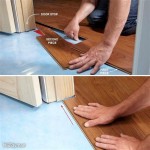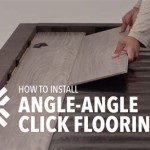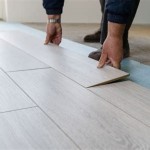Understanding Glue Strip Vinyl Plank Flooring
Glue strip vinyl plank flooring represents a specific type of resilient flooring designed for convenient and relatively straightforward installation. Unlike traditional glue-down vinyl plank, which requires adhesive applied across the entire subfloor, glue strip vinyl plank utilizes pre-applied adhesive strips along the edges of each plank. These adhesive strips allow the planks to adhere to one another, effectively creating a floating floor system. This method offers a faster and potentially less messy alternative to full-spread adhesive installations, making it a popular choice for both DIY homeowners and professional installers seeking efficiency.
The construction of glue strip vinyl plank flooring typically involves several layers. At its base is a backing layer, often made of vinyl or a composite material, providing stability and cushioning. Above this lies the core layer, which is usually composed of a dense vinyl or a similar resilient material. This core layer is crucial for the plank's dimensional stability and resistance to indentation. Atop the core layer is the decorative layer, which provides the visual appeal of the flooring. This layer is a high-quality printed image that replicates the look of natural wood, stone, or tile. Finally, a wear layer is applied to protect the decorative layer from scratches, scuffs, and fading. The thickness of this wear layer is a significant factor in determining the durability and suitability of the flooring for different levels of foot traffic. The adhesive strips are typically located along the edges of the core layer, allowing for a secure bond between adjacent planks.
The appeal of glue strip vinyl plank flooring lies in its combination of relative ease of installation, durability, and aesthetic versatility. It offers a visually appealing and comfortable flooring option that can withstand the rigors of daily life, while also providing a cost-effective alternative to more expensive flooring materials such as hardwood or ceramic tile. The water resistance of vinyl makes it suitable for areas where moisture is a concern, such as kitchens, bathrooms, and basements. Furthermore, the availability of various styles, colors, and textures makes it possible to achieve diverse design aesthetics to complement different interior styles.
Advantages of Glue Strip Vinyl Plank Flooring
Several advantages contribute to the popularity of glue strip vinyl plank flooring. These benefits range from simplified installation to enhanced durability and design flexibility.
One of the most significant advantages is the ease of installation. Unlike traditional glue-down vinyl plank, which requires meticulous application of adhesive across the entire subfloor, glue strip vinyl plank relies on pre-applied adhesive strips. This eliminates the need for specialized tools, such as trowels and rollers, and reduces the amount of time and effort required for installation. The process typically involves preparing the subfloor, aligning the planks, and pressing them together to activate the adhesive. This streamlined installation process makes it a viable option for DIY enthusiasts who may not have extensive experience with flooring installations. However, proper subfloor preparation remains critical for a successful and long-lasting installation. A level, clean, and dry subfloor is essential for ensuring that the planks adhere properly and that the floor remains stable over time.
Another key advantage is the water resistance of vinyl. Unlike hardwood, which can warp or swell when exposed to moisture, vinyl is inherently water-resistant. This makes glue strip vinyl plank flooring an ideal choice for areas prone to spills, such as kitchens and bathrooms. It also makes it a suitable option for basements, where moisture levels may be higher. The water resistance of vinyl also simplifies cleaning and maintenance. Spills can be easily wiped up without causing permanent damage to the floor. Regular sweeping and occasional damp mopping are typically sufficient to keep the flooring clean and looking its best. However, it's important to note that while the vinyl planks themselves are waterproof, the seams between the planks may not be completely impervious to water. Therefore, it's still important to address spills promptly to prevent water from seeping underneath the flooring.
Durability is another significant benefit of glue strip vinyl plank flooring. The wear layer, which protects the decorative layer from scratches and scuffs, is designed to withstand the rigors of daily use. The thickness of the wear layer is a key indicator of the flooring's durability. Thicker wear layers offer greater protection against wear and tear, making the flooring suitable for high-traffic areas such as hallways and living rooms. The resilient nature of vinyl also provides a degree of cushioning underfoot, making it more comfortable to walk on than harder flooring materials such as tile or concrete. This cushioning can also help to reduce noise transmission, making it a good choice for apartments or multi-story homes. However, it's important to choose a vinyl plank with an appropriate wear layer thickness for the intended use. For example, a flooring with a thinner wear layer may be suitable for a low-traffic bedroom, while a flooring with a thicker wear layer would be necessary for a high-traffic commercial space.
Considerations When Choosing Glue Strip Vinyl Plank Flooring
Despite its advantages, several factors should be considered when selecting glue strip vinyl plank flooring to ensure it meets specific needs and expectations. These considerations include subfloor preparation, adhesive quality, and the overall quality of the plank itself.
Subfloor preparation is paramount for a successful glue strip vinyl plank installation. The subfloor must be clean, level, and dry before installation can begin. Any debris, such as dirt, dust, or old adhesive, must be removed to ensure proper adhesion of the planks. Unevenness in the subfloor can cause the planks to flex or buckle, leading to premature wear and tear. Therefore, it's essential to repair any cracks or imperfections in the subfloor prior to installation. Self-leveling compounds can be used to create a smooth and even surface. Moisture is another critical factor to consider. Excess moisture in the subfloor can prevent the adhesive from bonding properly, leading to adhesion failures. A moisture test should be performed to ensure that the subfloor is sufficiently dry before installing the flooring. If moisture levels are too high, a moisture barrier may be necessary to prevent moisture from migrating through the subfloor and damaging the flooring. Failure to properly prepare the subfloor can result in a flooring installation that is prone to problems and has a significantly reduced lifespan.
The quality of the adhesive strips is another important consideration. The adhesive must be strong enough to hold the planks together securely, but also flexible enough to accommodate slight movements in the subfloor. The adhesive should also be resistant to moisture and temperature changes, to prevent it from becoming brittle or losing its adhesive properties over time. It is beneficial to research and select products from reputable manufacturers known for producing high-quality adhesive products. Reading reviews and seeking recommendations from professional installers can also provide valuable insights into the performance and reliability of different glue strip vinyl plank flooring options. Cheaper alternatives may use lower-quality adhesives that are more prone to failure, leading to planks separating or lifting over time. Investing in a higher-quality product with a reliable adhesive can help to ensure a long-lasting and trouble-free installation.
Lastly, the overall quality of the plank itself is crucial. This includes the thickness of the wear layer, the density of the core layer, and the quality of the decorative layer. As mentioned earlier, a thicker wear layer provides greater protection against scratches and scuffs, making the flooring more durable and long-lasting. The density of the core layer affects the plank's dimensional stability and its ability to resist indentation. A denser core layer will be less prone to compression under heavy furniture or foot traffic. The quality of the decorative layer affects the visual appeal of the flooring. Higher-quality decorative layers will have a more realistic and detailed appearance, and they will also be more resistant to fading over time. It's important to compare the specifications of different products and choose a flooring that meets the specific needs and requirements of the intended space. Consider factors such as the level of foot traffic, the presence of pets, and the exposure to moisture when making a selection. Opting for a higher-quality plank, even if it comes at a slightly higher cost, can ultimately result in a better-performing and longer-lasting flooring solution.
Installation and Maintenance Tips
Proper installation and ongoing maintenance are essential for maximizing the lifespan and preserving the appearance of glue strip vinyl plank flooring. Following recommended installation procedures and implementing appropriate cleaning and maintenance practices will help to ensure that the flooring remains in optimal condition for years to come.
Prior to installation, carefully review the manufacturer's instructions and recommendations. These instructions will provide specific guidance on subfloor preparation, plank alignment, and adhesive activation. It's essential to follow these instructions precisely to ensure a successful and long-lasting installation. Use appropriate tools, such as a utility knife, measuring tape, and straight edge, to cut and fit the planks accurately. When aligning the planks, ensure that the adhesive strips are properly engaged to create a secure bond. After installation, allow the adhesive to cure completely before subjecting the flooring to heavy traffic or furniture. The curing time will vary depending on the specific adhesive used, so refer to the manufacturer's instructions for guidance. Furthermore, consider the ambient temperature and humidity during installation. Extreme temperatures or high humidity levels can affect the adhesive's performance. It's best to install the flooring in a climate-controlled environment to ensure optimal adhesion.
Regular cleaning and maintenance are crucial for preserving the appearance and extending the lifespan of glue strip vinyl plank flooring. Sweep or vacuum the floor regularly to remove dirt, dust, and debris. Use a soft-bristled broom or a vacuum with a felt brush attachment to avoid scratching the surface. Avoid using abrasive cleaners or scouring pads, as these can damage the wear layer. Clean spills promptly with a damp cloth or mop. Use a mild detergent specifically designed for vinyl flooring. Avoid using harsh chemicals or solvents, as these can discolor or damage the flooring. For stubborn stains, try using a solution of baking soda and water. Apply the solution to the stain, let it sit for a few minutes, and then gently wipe it away with a clean cloth. Rinse the area with clean water and dry thoroughly.
Protective measures can also help to prevent scratches and dents. Use furniture pads under the legs of chairs and tables to prevent them from scratching the floor. Place mats or rugs in high-traffic areas, such as entrances and hallways, to protect the flooring from dirt and wear. Avoid wearing shoes with high heels or sharp objects on the floor. If moving heavy furniture, protect the floor with a blanket or furniture sliders. Over time, the wear layer may become scratched or dulled. Consider using a commercial vinyl floor polish to restore the shine and protect the surface. Follow the manufacturer's instructions carefully when applying polish. By implementing these simple cleaning and maintenance practices, it's possible to keep glue strip vinyl plank flooring looking its best for years to come.

10 Ft Self Adhesive Vinyl Floor Transition Strip Com

Trafficmaster High Point Chestnut 4 Mil X 6 In W 36 L Grip Strip Water Resistant Luxury Vinyl Plank Flooring 24 Sqft Case 83313 The Home Depot

A Beginner S Guide To Installing Vinyl Plank Flooring Dumpsters Com

Art3d Brown 1 57 In X 120 Self Adhesive Vinyl Transition Strip For Joining Floor Gaps Tiles A179hd54 The Home Depot

How To Install A T Molding Glue Down

How To Remove Self Adhesive Vinyl Floor Planks L And Stick Pvc Tiles

Vinyl Vs Laminate Flooring Pros Cons And Differences Forbes Home

How To Remove Vinyl Flooring Glue

Art3d Aspen Yellow 1 57 In X 120 Self Adhesive Vinyl Transition Strip For Joining Floor Gaps Tiles A179hd53 The Home Depot

Review Self Adhesive Vinyl Plank Tile
Related Posts








